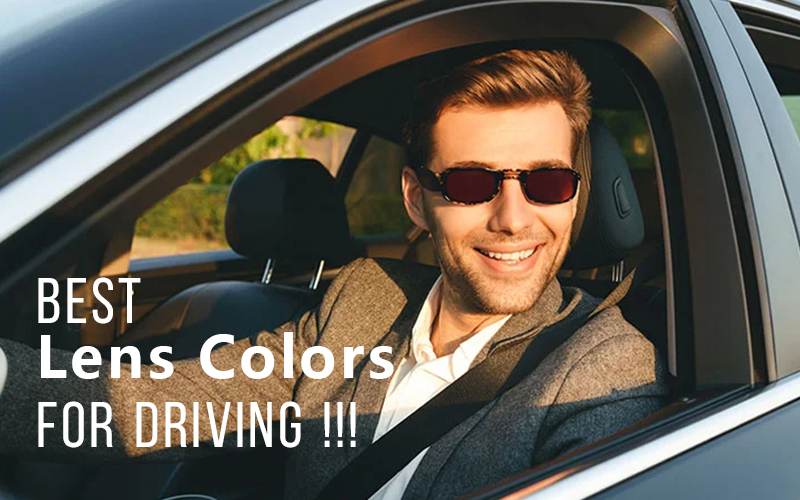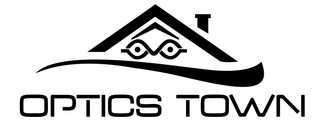
Are you wondering which color sunglass lens is best for driving? At Optics Town, we aim to help you find the perfect pair for every road trip, ensuring you drive with clarity and confidence. Different lens colors offer unique benefits for various driving conditions. From boosting contrast to reducing glare, selecting the appropriate lens color can improve your visibility on the road.

Best Lens Colors for Driving
Neutral vs. Contrast-Enhancing
- Neutral Lens Colors: Gray, Brown, or Green: These colors provide a natural color experience and are ideal for everyday driving. They reduce overall brightness without distorting colors, making them suitable for varied light conditions.
- Contrast-Enhancing Lens Colors: Red or Amber: These colors enhance color perception and are beneficial on overcast days or in low-light situations. They can improve depth perception and help you quickly recognize hazards on the road.
Neutral sunglass lens colors like gray, brown, or green provide a natural color experience. These are great for everyday driving in various light conditions.
On the other hand, contrast-enhancing lens colors such as red or amber boost color perception. They are helpful on overcast days or in low-light situations. For reducing glare and enhancing visibility on the road, polarized lenses are highly recommended, regardless of the lens color.
While neutral lenses offer better color accuracy and versatility for daily wear, contrast-enhancing lenses can aid in depth perception and recognizing hazards quickly. Consider factors like frame fit, comfort, and UV protection when selecting driving sunglasses. It’s important to consult opticians or shop for prescription driving glasses with accurate measurements for optimal vision and protection on the road.

Polarization Benefits
Polarized lenses in sunglasses are great for driving.
- Glare Reduction: Polarized lenses minimize glare from reflective surfaces like water, snow, and other vehicles. This reduces eye strain and improves visibility.
- Enhanced Contrast: Different lens colors, such as red or amber, can further enhance contrast, making it easier to see road features.
- UV Protection: Polarized lenses protect your eyes from harmful UV rays, contributing to overall eye health and comfort.
They help reduce glare from reflective surfaces like water, snow, and other vehicles on the road. This glare reduction makes it easier to see the road and hazards more clearly. Different lens colors like red and clear can enhance contrast and improve vision in different light conditions.
Polarized lenses also protect the eyes from harmful UV rays and add a touch of fashion and comfort. They are a practical choice for long-distance driving or daily commutes. Opticians recommend polarized sunglasses for driving as they ensure accurate vision measurements and prescription values. Brands like Maui Jim and Transition offer a variety of lens colors and styles to match individual preferences.
Night Driving Considerations
When driving at night, it’s important to choose the right sunglass lens colors. This helps improve vision and minimize risks on the road.
- Contrast-Enhancing Lenses: Colors like red or clear can improve clarity and reduce glare from headlights and streetlights.
- Polarized Lenses: While less critical at night, they still provide UV protection and enhance contrast.
- Comfort: Choose frames that fit well and are comfortable for extended use.
Consider using contrast-enhancing lenses like 1. red or 2. clear ones. These can enhance clarity and reduce glare from headlights or streetlights. Polarized lenses are also beneficial. They offer better protection against UV rays and improve contrast for safer driving. Selecting a frame that fits well and is comfortable for long distances is essential for clear vision.
Choosing the right lens tint and coating ensures accurate color perception and clarity while driving at night. Opticians recommend transition lenses for prescription driving glasses. These lenses adjust to different light conditions and provide sun protection. Mirrored glasses can be a stylish and functional option for night driving, offering UV protection and clarity in low-light settings.
Everything of Driving sunglasses at Optics Town
At Optics Town wholesale eyeglasses, a plethora of driving sunglasses awaits, each designed to enhance the driving experience in distinct ways. From amber-tinted lenses that heighten contrast and depth perception in varied light conditions to gray lenses that maintain true color perception while reducing overall brightness, customers can find an array of options tailored to their preferences. Polarized lenses diminish glare from reflective surfaces such as roads and water, ensuring clarity and safety on the road. Additionally, yellow lenses excel in low-light settings, augmenting visibility during dawn or dusk drives. With options ranging from classic aviators to sleek wraparound frames, Optics Town offers a spectrum of driving sunglasses that combine style with functionality, promising clear vision and comfortable journeys ahead.
Best Wholesale Driving Sunglasses for Option
Optics Town has the best wholesale driving sunglasses in the market, we have a professional team for sunglasses design, and Optics Town provides top-quality wholesale driving sunglasses with the following features:
- Lens Colors: Red or clear lenses for optimal contrast and glare reduction.
- Polarization: Essential for glare reduction and enhanced clarity.
- Frame Fit: Crucial for comfort during long drives, ensuring sunglasses stay securely in place.
- Transition Lenses: Adapt to various light conditions, offering versatility and protection.
With accurate measurements and prescription driving glasses, protect your vision on the road with the best wholesale driving sunglasses available.
Conclusion
When driving, wear sunglasses with gray, brown, or green lenses. These colors reduce glare and improve visibility. Neutral colors like gray, brown, or green enhance contrast and maintain color balance. This reduces eye strain while driving. Avoid pink, blue, or yellow lenses as they can distort colors and hinder visibility on the road. Choose Optics Town’s bulk sunglasses for sale that comply with safety standards for optimal protection while driving.
FAQ
Q: What color sunglass lens is best for driving during the daytime?
A gray or brown tinted lens is best for driving during the daytime as they provide natural colors and reduce glare. Avoid colors that distort traffic signals, such as green or blue.
Q: Are polarized lenses better for driving?
A: Yes, polarized lenses are better for driving as they reduce glare from the sun and reflections off of surfaces like other cars or wet roads, providing better visibility and reducing eye strain. This can improve safety while driving.
Q: Is a gray lens or a brown lens better for driving in bright sunlight?
A: A gray lens is better for driving in bright sunlight as it provides true color perception. It also reduces overall brightness while maintaining sharpness. Brown lenses can distort color perception, making it harder to differentiate between colors like red and green in traffic signals.
Q: Should I choose a yellow lens for driving in low light conditions?
A: Yes, a yellow lens can improve visibility in low light conditions by enhancing depth perception and reducing glare. For example, yellow lenses can help in foggy or rainy weather, as they can provide better contrast and sharpen your vision on the road.
Q: Are there specific lens colors that are recommended for driving at night?
A: Yes, yellow, gold, or amber tinted lenses are recommended for driving at night as they can help reduce glare, enhance contrast, and improve depth perception. Examples include polarized yellow lenses or anti-reflective coated amber lenses.




